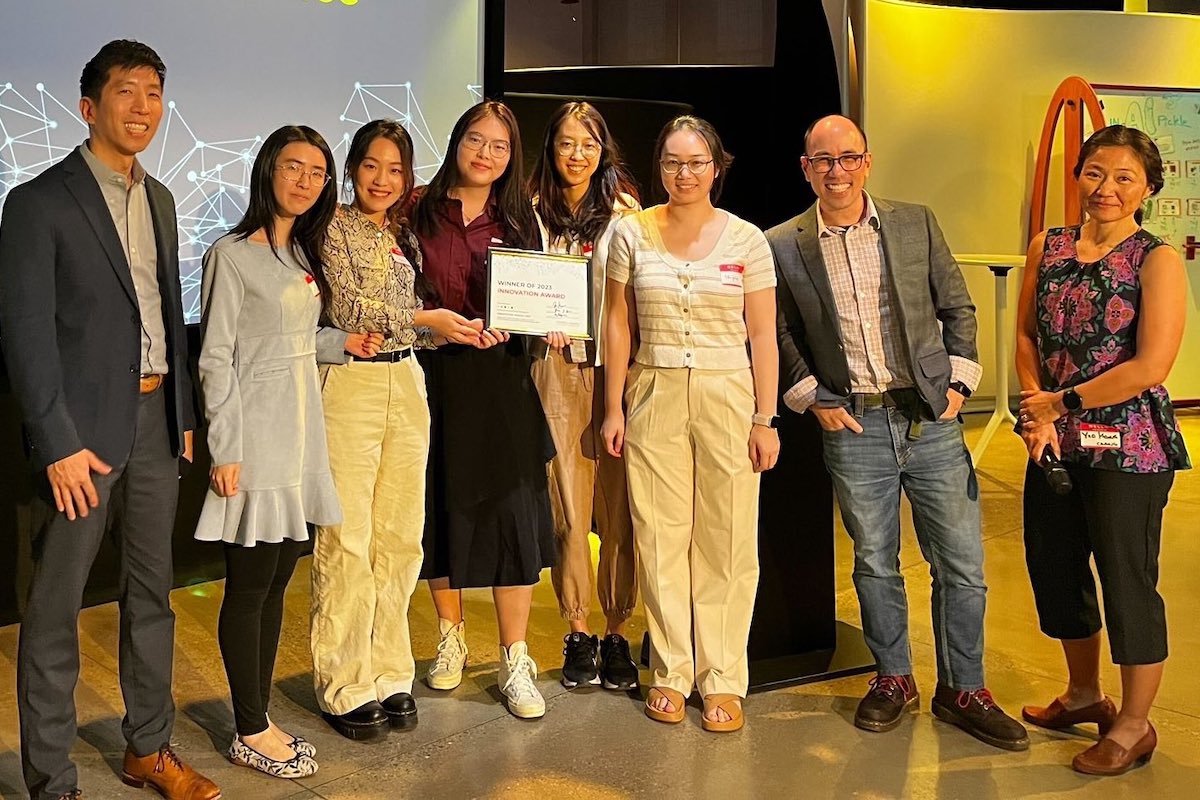Imagine, with just a few taps you’ve transformed a journal entry into a short piece of music that encapsulates your feelings. If the winning project at the 2023 Innovation Awards (INA) was made into an app, you’d be able to do exactly that.
INA —a design thinking incubator program established in 2017 by the steering committee, Jin Kuwata, Joey Lee and Yoo Kyung Chang from the Communication, Media, Learning Technologies Design Program (CMLTD) as a part of the TC EdTech Initiative—draws in students across Teachers College and Columbia University and challenges them to imagine a research-backed EdTech solution to any number of problems in the world. After a whirlwind six weeks, a winning project emerged: Project aMuse, an AI-powered music journaling app with an adorable cat assistant that was inspired by the design team’s desire to help young people express themselves.
Members from the winning team—composed of Dora Zhang, Jianan Liang, Shiyue Peng, Yolanda Xing and Xichen Li—sat down with TC to discuss their big takeaways from the whirlwind process of INA.
In order to make real progress, the team had to look inward
The students found their calling during the first brainstorm: how can we help young people express themselves? Each team member was personally invested in the problem, but issues arose when it came time to work towards a solution, in part because it was something they each cared deeply about.
“Everyone has a different understanding of what self-expression means, what making music means,” says Dora. Because of that, it was hard to narrow the focus and pick a single direction for the project. It wasn’t until week four that the team found solid footing by looking at where their skills intersected with the needs of users. “That was something we learned,” says Jianan, “...when we do something in this world, it's not just about knowing what the world needs, but also seeing what we are good at and what we can bring to the world.”
The experience of INA gave them new approaches to communication
Getting Project aMuse ready for presentation required a new kind of teamwork for each member. As Yolanda notes, sometimes teamwork is more than synthesizing ideas, it requires persuasion and choosing one perspective over another. And throughout the process, each team member recognized a need for more flexibility and effective communication in order to make it across the finish line.
That was the biggest lesson for Xichen, the team’s lead researcher. By the end of the project she had amassed 40-50 pages of research and found it “very challenging to communicate ideas from academia to my teammates,” especially because she was researching up until the deadline. By the end of INA she was able to push to have her ideas shared, but noted that communicating “bit by bit so that people can digest [the research]” would’ve brought the team on the same page much sooner.
Other team members, such as Jianan, had to learn how to go with the flow and learn from surprises. By letting go of some control, she “learned to understand others more and try to find possible connections between people's ideas.” On the other end of the spectrum, Shiyue felt a need to take more initiative instead of letting people direct her because “it's very important to collaborate with each other instead of waiting for someone to assign work to you,” she says.
Creating Project aMuse gave team members new insight into themselves and their work
By the time they won INA, each member of the team emerged with a new appreciation of music, AI and product design. A few members are particularly interested in continuing to iterate on Project aMuse.
Instead of centering on self-expression, Yolanda wants to explore the ways that aMuse can make composition less overwhelming. As a musical novice, she’s looking to utilize AI as a scaffold to teach users the basics of music composition. But Yolanda is still in the early exploratory phase because “turning all the theories into designs is another thing. It’s totally another thing.”
Dora also hopes to continue her INA work, ideally collaborating with Yolanda. She says doing the project helped “regain my faith in the power of design” and taught her the importance of grounding design decisions in research and learning theories. While she hasn’t continued working on Project aMuse—and has also researched the potential of AI as a therapy facilitator— she says “we are exploring how to best make the interface user-friendly, but in a way that sparks the most meaningful learning experience.”
Taking a slightly skeptical approach, Xichen’s desires to continue work on Project aMuse come from her curiosity and concern about whether music making and performance can truly be moved online. She feels that “the power of music also comes from the space” it’s performed in but that said, Xichen deeply enjoyed the topic. Perhaps most surprisingly, doing INA inspired her to consider becoming a music therapist. She always had an appreciation for therapists but convinced herself that it was out of reach. “But after this project, I find that if you work on something you’re really enthusiastic about, you can achieve impossible things,” she says.
